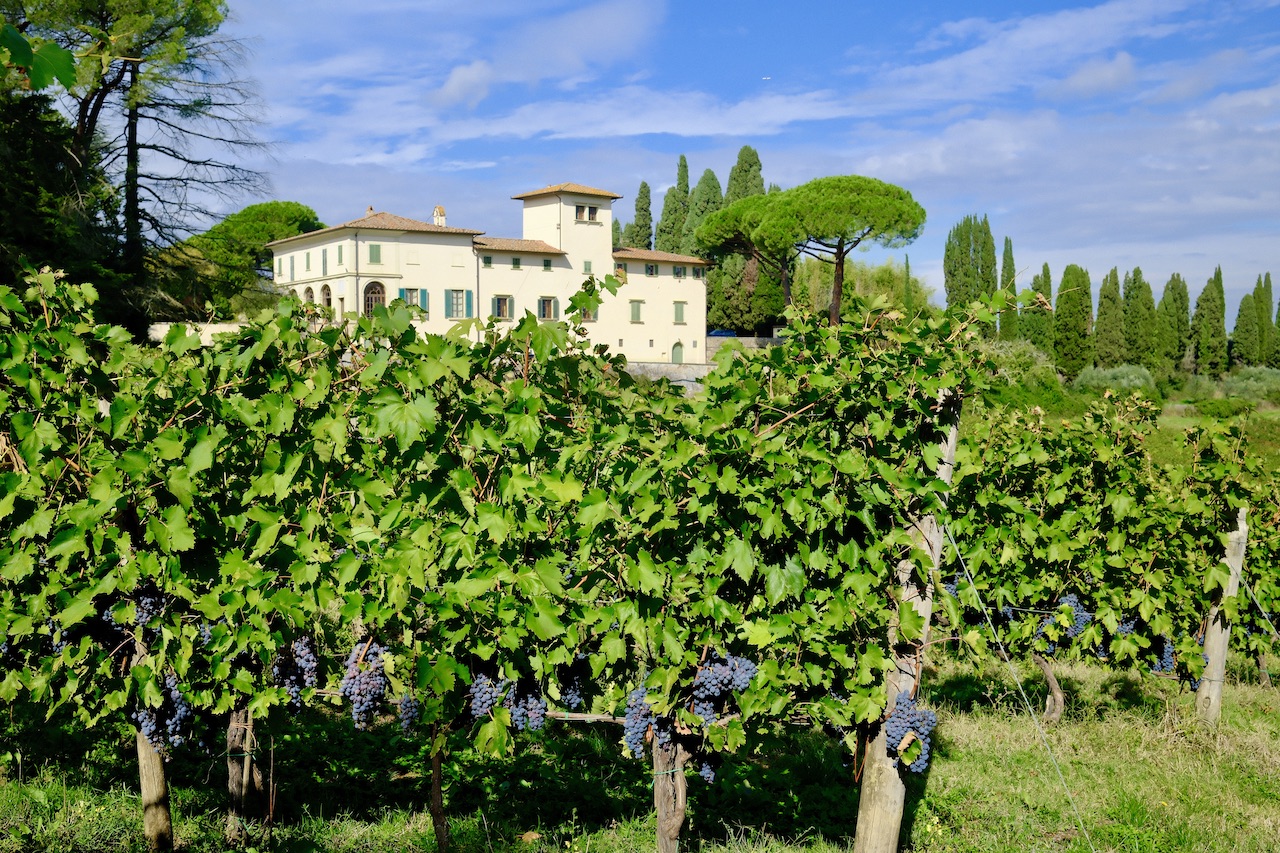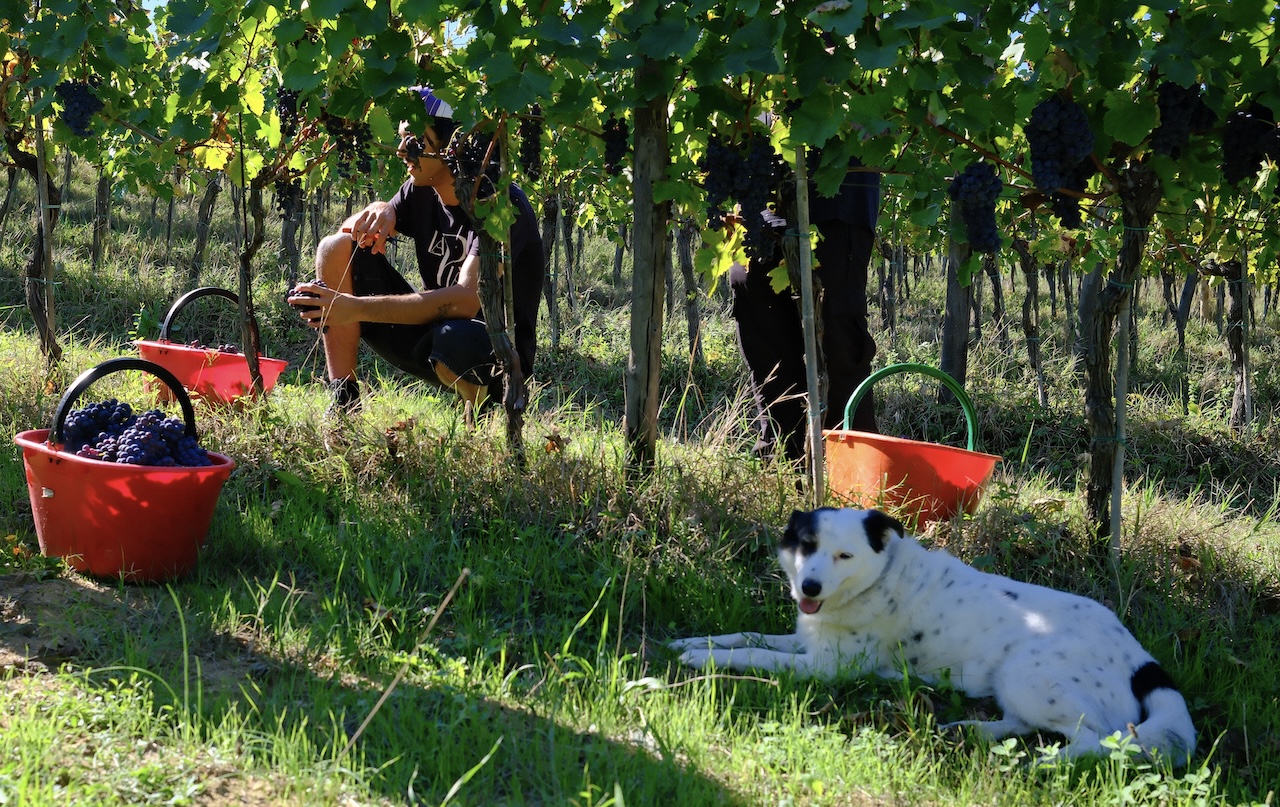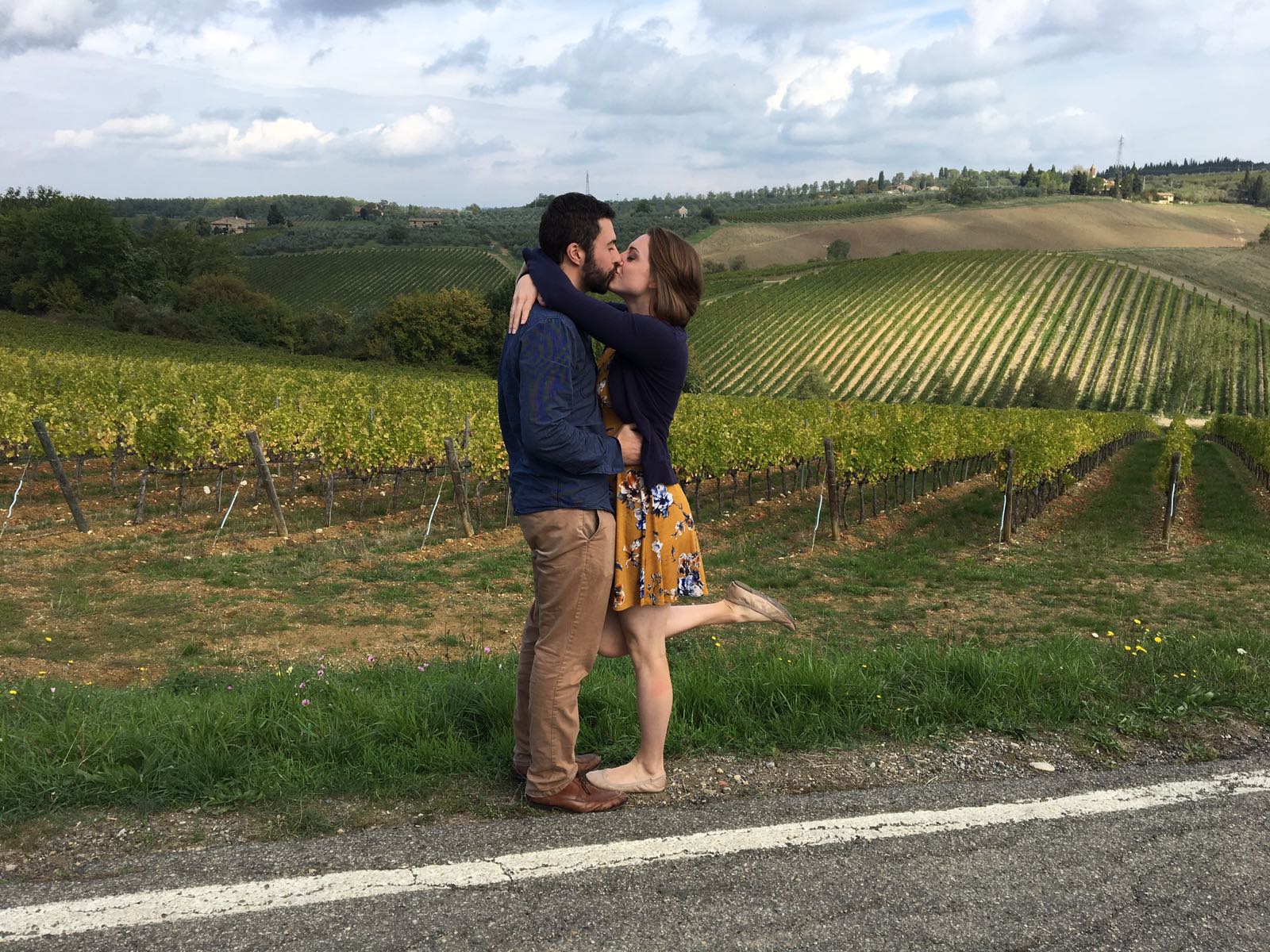Wine Tours in Tuscany - About Angie - +39 3333185705 - angie.chianti@gmail.com
The Chianti region in Tuscany is a dream destination for wine lovers. With its cypress-lined roads, historic hilltop villages, and rows of Sangiovese vines, it offers an unforgettable journey through Italian winemaking heritage.
Whether you’re a seasoned wine enthusiast or a curious traveler planning your first Florence to Chianti wine tour, this updated guide will take you through the top Chianti wineries to visit, explain what makes Chianti wines so special, and help you plan an exceptional Tuscan experience.
Table of Contents

Why Visit Chianti Wine Vineyards?
Chianti is one of the most iconic wine regions in the world, producing wines that are both elegant and accessible. The signature Sangiovese grape gives Chianti wines their bright acidity, cherry and plum notes, earthy undertones, and age-worthy structure.
Visiting Chianti vineyards offers more than just tastings—it’s a dive into centuries-old traditions, beautiful countryside, and warm Tuscan hospitality. Many wineries are family-owned, where generations still oversee the harvest, aging, and bottling process.
How to Visit Chianti Wineries in 2025: Do You Need to Book in Advance?
Yes, you should book. Over the past few years, many Chianti wineries—especially boutique estates and top-rated producers—have shifted to reservation-only visits, often hosting small groups for personalized tastings.
Booking in advance ensures:
- Access to exclusive winery experiences
- Private or semi-private tastings
- Tours in English led by sommeliers or winemakers
- Seasonal pairings with local foods
💡 Tip: Book your wine tour from Florence early, especially between May and October.
6 Best Chianti Wine Vineyards to Visit in 2025
Each winery below offers something unique—whether it’s stunning architecture, family heritage, organic farming, or world-class Super Tuscans.
1. Castello di Verrazzano – Historic Elegance
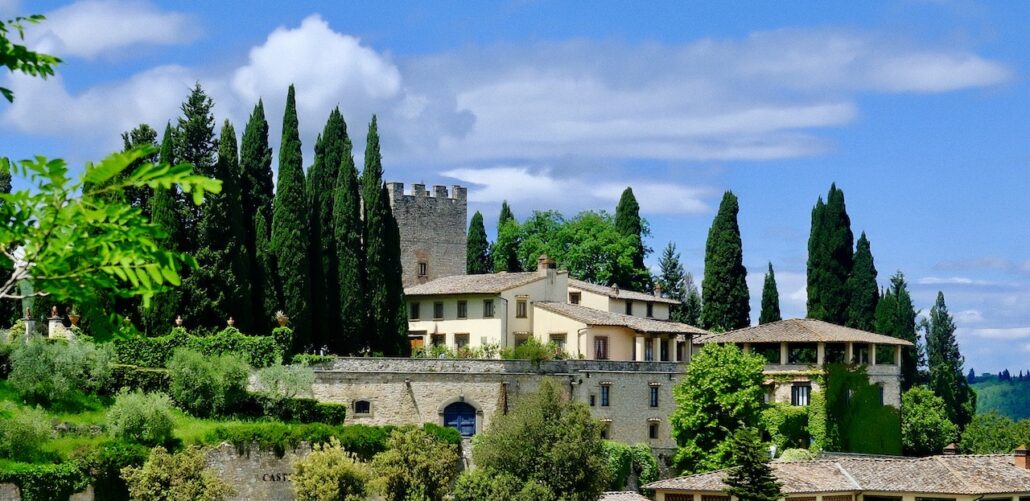
📍 Near Greve in Chianti
Perched atop the rolling hills of Greve in Chianti, Castello di Verrazzano is more than just a winery; it’s a testament to centuries of history, exploration, and viticulture. Once the ancestral home of the famed explorer Giovanni da Verrazzano, the estate seamlessly blends its storied past with modern winemaking excellence.
🌿 Estate Overview
- Location: Greve in Chianti, Tuscany, Italy
- Elevation: Approximately 348 meters (1,142 feet) above sea level
- Total Estate Size: Approximately 230 acres (93 hectares), with 52 hectares dedicated to vineyards
- Organic Certification: Certified organic since the 2014 vintage
The estate’s vineyards benefit from the unique “Formazione di Sillano” soils—a composition of 43% limestone, 29% clay, and 28% sand—providing optimal conditions for cultivating high-quality grapes.
👨👩👧👦 Current Ownership: The Cappellini Family
Since 1958, Luigi and Silvia Cappellini have been the custodians of Castello di Verrazzano. Their dedication to preserving the estate’s heritage while implementing sustainable and organic farming practices has solidified the winery’s reputation in the Chianti Classico region.
🍇 Vineyard and Grape Varieties
The vineyards are predominantly planted with Sangiovese, the cornerstone of Chianti Classico wines. Other red varieties include Merlot, Canaiolo, Cabernet Sauvignon, and Colorino. A small portion is dedicated to white grapes like Trebbiano Toscano, Traminer, and Malvasia Lunga del Chianti.
🍷 Wine Portfolio and Grape Composition
1. Chianti Classico DOCG
- Grape Composition: 95% Sangiovese, 5% complementary red grapes from the estate
- Vinification: Fermentation at controlled temperatures with a maximum of 28°C
- Aging: Aged in large Slavonian oak barrels
2. Chianti Classico Riserva DOCG
- Grape Composition: Predominantly Sangiovese with a small percentage of complementary red grapes
- Aging: Extended aging in oak barrels to enhance complexity
3. Chianti Classico Gran Selezione “Sassello” DOCG
- Grape Composition: 100% Sangiovese
- Aging: Aged in new French oak barriques (Allier and Vosges) for a refined structure
4. Toscana IGT “Bottiglia Particolare”
- Grape Composition: Blend of Sangiovese, Cabernet Sauvignon, and Merlot
- Aging: Aged in French oak barrels to achieve a harmonious balance
5. Toscana IGT “Verrazzano Rosso”
- Grape Composition: Predominantly Sangiovese with Merlot and other red varieties
- Profile: Fruity and approachable, suitable for early consumption
6. Vin Santo del Chianti Classico DOC
- Grape Composition: Trebbiano Toscano and Malvasia Lunga del Chianti
- Aging: Aged in small oak barrels, offering a rich and complex dessert wine
🏡 Accommodations: Foresteria Castello di Verrazzano
For guests wishing to immerse themselves in the Tuscan countryside, the estate offers the Foresteria Castello di Verrazzano, featuring:
- Accommodations: Two independent apartments and six double rooms, some with the option for an extra bed
- Amenities: Rooms are decorated in traditional Tuscan style, providing a rustic yet comfortable ambiance
- Swimming Pool: A large outdoor pool (6 x 12 meters) is available for guests, perfect for relaxation amidst the vineyards
- Additional Facilities: The property boasts a garden, barbecue area, and recreational spaces for children
🕰️ Visiting and Wine Tours
Castello di Verrazzano offers guided tours of its historic cellars, providing insights into the winemaking process and the estate’s rich history. Tastings are available, showcasing a selection of their esteemed wines.
- Opening Hours: Typically open from 10:00 AM to 1:00 PM and 2:00 PM to 5:00 PM for tastings and purchases
- Booking: It’s advisable to book tours and tastings in advance, especially during peak seasons
🌍 Giovanni da Verrazzano: The Explorer’s Legacy
Born in 1485 at Castello di Verrazzano, Giovanni da Verrazzano was a pioneering navigator who charted the Atlantic coast of North America in 1524 under the commission of King Francis I of France. His explorations led to the discovery of New York Harbor, Narragansett Bay, and other significant coastal regions. Verrazzano’s contributions are commemorated by the Verrazzano-Narrows Bridge in New York City, named in his honor.
2. Castello di Radda – Sangiovese Precision
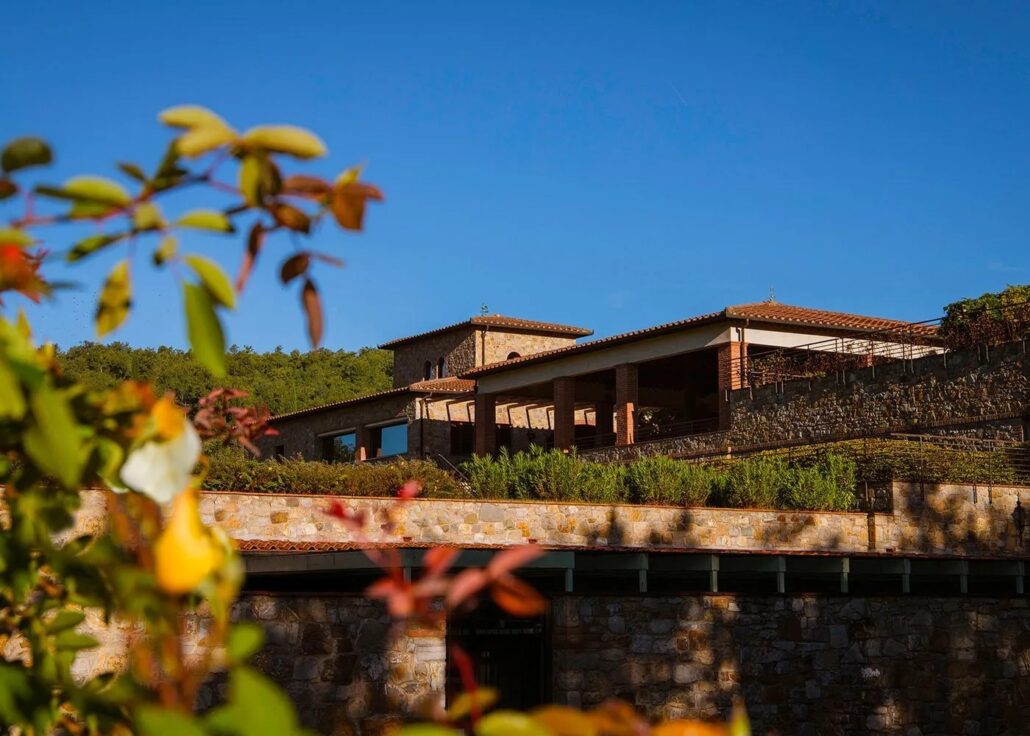
📍 Radda in Chianti
🏰 Castello di Radda: A Modern Expression of Chianti Classico Heritage
Nestled in the heart of Tuscany’s Chianti Classico region, Castello di Radda embodies a harmonious blend of tradition and innovation. Established in the early 2000s by the Gussalli Beretta family, the estate is renowned for its commitment to sustainable viticulture and the production of wines that reflect the unique terroir of Radda in Chianti.
🌿 Estate Overview
- Location: Radda in Chianti, Siena, Tuscany, Italy
- Total Estate Size: Approximately 45 hectares (111 acres) under vine
- Vineyards: Situated at elevations around 400 meters, with south, southeast, and southwest exposures
- Soil Type: Predominantly calcareous-clay with a significant presence of alberese (limestone)
- Farming Practices: Transitioned to organic cultivation, emphasizing low yields and environmental sustainability
👨👩👧👦 The Gussalli Beretta Family Legacy
The Gussalli Beretta family, with deep roots in Italian industry, ventured into winemaking with a vision to craft wines that honor the heritage of Chianti Classico. Their acquisition of Castello di Radda marked a commitment to excellence, with investments in state-of-the-art facilities and sustainable practices. The family’s philosophy centers on producing wines that are authentic expressions of their origin, balancing tradition with modernity.
🍇 Vineyards and Grape Varieties
- Primary Varietals: Sangiovese (comprising the majority of plantings)
- Complementary Varietals: Canaiolo, Colorino, and small quantities of Merlot
- Viticultural Practices: Emphasis on organic farming, minimal intervention, and the preservation of indigenous grape varieties
🍷 Signature Wines and Grape Composition
1. Chianti Classico DOCG
- Grape Composition: 95% Sangiovese, 5% Canaiolo
- Aging: Aged in large oak barrels and tonneaux
- Tasting Notes: Fragrant and savory with persistent notes of woodland berries, spices, and vanilla
2. Chianti Classico Riserva DOCG
- Grape Composition: 100% Sangiovese
- Aging: Aged in oak barrels for 24 months
- Tasting Notes: Elegant and structured, showcasing ripe red fruit, floral nuances, and well-integrated tannins
3. Chianti Classico Gran Selezione DOCG “Vigna Il Corno”
- Grape Composition: 100% Sangiovese
- Aging: Extended aging in oak barrels
- Tasting Notes: Complex and refined, with layers of dark cherry, spice, and mineral undertones
4. Rosato Toscana IGT
- Grape Composition: Predominantly Sangiovese
- Aging: Short aging in stainless steel to preserve freshness
- Tasting Notes: Crisp and vibrant, featuring notes of red berries and floral hints
5. Rosso Toscana IGT
- Grape Composition: Blend of Sangiovese and Merlot
- Aging: Aged in a combination of stainless steel and oak barrels
- Tasting Notes: Medium-bodied with balanced acidity, showcasing red fruit and subtle spice
🏡 Hospitality and Accommodations
While Castello di Radda does not offer on-site accommodations, visitors can find a range of nearby lodging options
🕰️ Wine Experiences and Tours
Castello di Radda offers a variety of immersive experiences for visitors:
- Classic Wine Tasting: A guided tasting of the estate’s signature wines, providing insights into their production and characteristics.
- Food and Wine Pairing: An exploration of traditional Tuscan cuisine paired with Castello di Radda wines.
- Vineyard Tour: A walk through the vineyards, discussing viticultural practices and the unique terroir of the region.
Booking: Reservations can be made through the estate’s website or by contacting the hospitality team directly.
3. Tenuta di Nozzole – Family Tradition
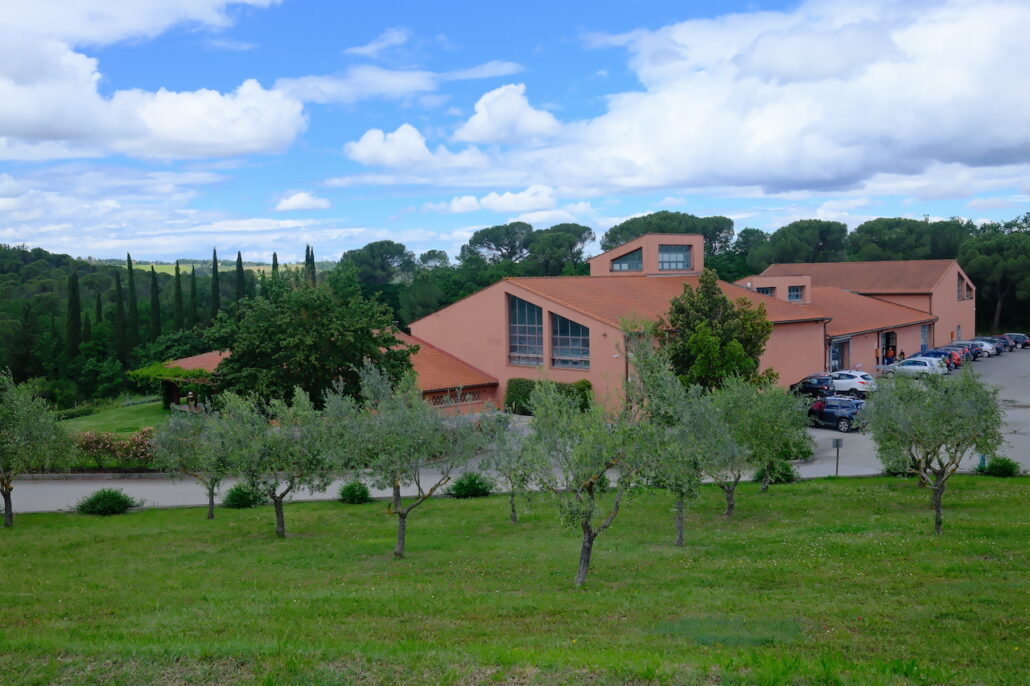
📍 Outside Greve in Chianti
Nestled in the hills of Greve in Chianti, Tenuta di Nozzole blends centuries-old Tuscan heritage with a modern approach to fine winemaking. With its expansive estate, diverse varietals, and luxury hospitality, it stands as a cornerstone of the Chianti Classico DOCG region.
🏞️ Estate Overview
- Location: Greve in Chianti, Tuscany, Italy
- Total Area: 385 hectares
- Vineyard Area: Over 90 hectares
- Elevation: Around 300 meters above sea level
- Soil Composition: Clay and limestone-rich marl, ideal for Sangiovese
The estate benefits from a prime hillside location and careful clonal selection, enhancing both vineyard health and grape quality.
🏰 Historical Significance
Origins and Ownership
Tenuta di Nozzole is documented as far back as the 14th century in the Cronache Fiorentine by Villani. In 1971, it was acquired by the Folonari family, a historic name in Italian wine.
The Folonari Legacy
Under the leadership of Ambrogio and Giovanni Folonari, the estate has evolved into a benchmark for Tuscan excellence. Their philosophy merges tradition with continuous innovation, allowing Nozzole’s wines to shine globally.
🍇 Vineyard and Grape Varieties
The estate focuses primarily on Sangiovese, the hallmark grape of Chianti Classico. Additional varietals include:
- Cabernet Sauvignon – for bold IGT reds
- Chardonnay – used for refined, mineral-driven whites
All grapes are estate-grown and hand-harvested to ensure maximum quality and control.
🍷 Wine Portfolio and Grape Composition
1. Nozzole Chianti Classico DOCG
- Grapes: 100% Sangiovese
- Style: Classic and balanced, a pure expression of the region
- Vinification: Stainless steel with aging in traditional oak
2. La Forra Chianti Classico Riserva DOCG
- Grapes: 100% Sangiovese
- Vine Age: From 35-year-old vines
- Style: Deep, structured, and cellar-worthy
3. Giovanni Folonari Gran Selezione DOCG
- Grapes: 100% Sangiovese
- Style: The estate’s top-tier Chianti, complex and elegant
- Aging: French oak barriques for enhanced finesse
4. Il Pareto Toscana IGT
- Grapes: 100% Cabernet Sauvignon
- Style: A powerful Super Tuscan with intense concentration
- Aging: 16 months in new oak
5. Le Bruniche Chardonnay Toscana IGT
- Grapes: 100% Chardonnay
- Style: Crisp, mineral, and lightly oaked
🏡 Hospitality and Accommodations
Villa Nozzole – Luxury in the Vines
- Bedrooms: 9 elegant double rooms
- Design: 17th-century Tuscan architecture with modern comfort
-
Amenities:
- Private heated swimming pool
- Panoramic countryside views
- Expansive gardens and outdoor dining areas
Villa Nozzole is ideal for family stays, wine retreats, and small events.
🍽️ Wine Experiences and Tours
Tenuta di Nozzole welcomes guests with guided tours of the estate and cellars, followed by tastings of its top labels. Visitors can also experience:
- Vineyard walks
- Food and wine pairings
- Seasonal events hosted by the Folonari team
4. Castello di Volpaia: A Medieval Village Transformed into a Living Winery in the Heart of Chianti Classico
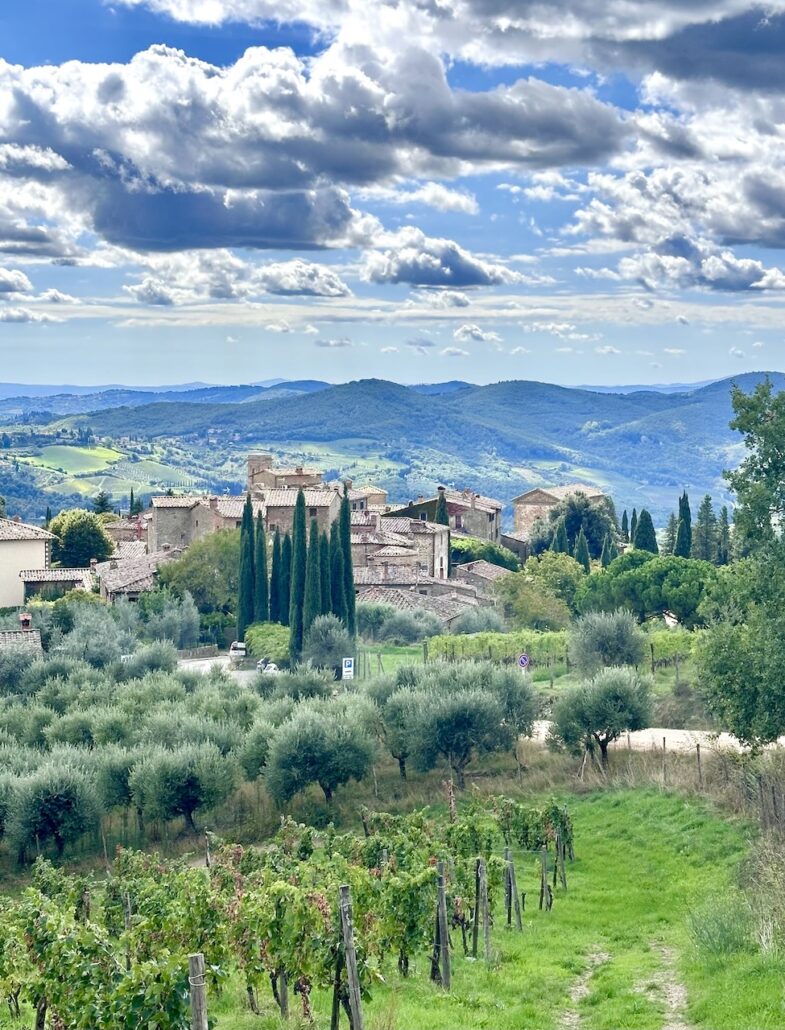
📍 Volpaia
Perched high in the hills of Radda in Chianti, Castello di Volpaia is not just a winery—it’s a beautifully preserved medieval village where winemaking unfolds across an entire borgo. This “scattered cellar” integrates modern winemaking into centuries-old buildings, creating one of Tuscany’s most unique and atmospheric wine experiences.
🌿 Estate Overview
- Location: Radda in Chianti, Tuscany, Italy
- Altitude: 450–600 meters above sea level
- Total Estate Size: Approx. 360 hectares
- Vineyards: 46 hectares, certified organic
- Soil Type: Predominantly sandstone with pockets of clay and limestone
Volpaia’s vineyards are among the highest in the Chianti Classico zone, contributing to the vibrant acidity and elegance of its wines.
👨👩👦 Ownership and Family
Castello di Volpaia is owned and managed by the Mascheroni Stianti family. Since the 1970s, Carlo and Giovannella Mascheroni Stianti have led the restoration of the ancient hamlet, converting its towers, chapels, and stone homes into interconnected winery facilities. Today, their son Niccolò Mascheroni Stianti carries the family tradition forward with a focus on innovation and sustainability.
🍇 Vineyards and Grape Varieties
- Main Grapes: Sangiovese (primary), with small plots of Merlot and Mammolo
- Organic Certification: Certified organic since 2000
- Notable Vineyard Plots: Campo a Pitti, Casavecchia, Castellino, and Santa Maria Novella
The estate’s diverse terroir and high-altitude vineyards give rise to expressive, long-lived wines with natural freshness and finesse.
🍷 Wine Portfolio and Grape Composition
1. Chianti Classico DOCG
- Grapes: 90% Sangiovese, 10% Merlot
- Aging: 12 months in large Slavonian oak casks
- Tasting Notes: Lively ruby red, aromas of fresh cherry and red currant, balanced palate with crisp acidity and soft tannins
2. Chianti Classico Riserva DOCG
- Grapes: 100% Sangiovese
- Aging: 24 months in oak barrels, 3 months in bottle
- Tasting Notes: Deep cherry and plum aromas, layered spice, fine tannins, and a lingering mineral finish
3. Chianti Classico Gran Selezione “Coltassala” DOCG
- Grapes: 95% Sangiovese, 5% Mammolo
- Aging: 18 months in French oak barriques, 12 months in bottle
- Tasting Notes: Rich and intense, with black cherry, wild herbs, and elegant oak integration
4. Balifico Toscana IGT
- Grapes: Cabernet Sauvignon and Sangiovese
- Style: A refined Super Tuscan from mountain vineyards, showcasing structure and dark berry richness
5. Vin Santo del Chianti Classico DOC
- Grapes: Trebbiano Toscano and Malvasia del Chianti
- Aging: 5 years in small oak barrels (caratelli)
- Tasting Notes: Golden amber color, notes of dried apricot, fig, honey, and caramel; velvety and concentrated
🏡 Hospitality and Accommodations
Castello di Volpaia offers a selection of authentic village accommodations within restored 14th-century homes:
- Options: Country-style apartments and rooms, including Casa Ricci and Casa Olinto
- Swimming Pool: Outdoor pool available for guests, tucked away in a serene part of the village
- Other Amenities: Garden, BBQ area, Wi-Fi, panoramic views
Guests enjoy the rare chance to live and sleep inside an ancient wine village, surrounded by vineyards and history.
🕰️ Wine Experiences and Tours
The winery offers immersive guided tours of the village-based winery and cellars, often followed by tastings of its organic wines. Experiences include:
- Cellar visits integrated into medieval buildings
- Olive oil mill and wine museum
- Wine tastings and food pairings
- Seasonal events and cooking classes
Advance booking is recommended, especially during spring and fall.
5. Antinori nel Chianti Classico – Innovation & Architecture
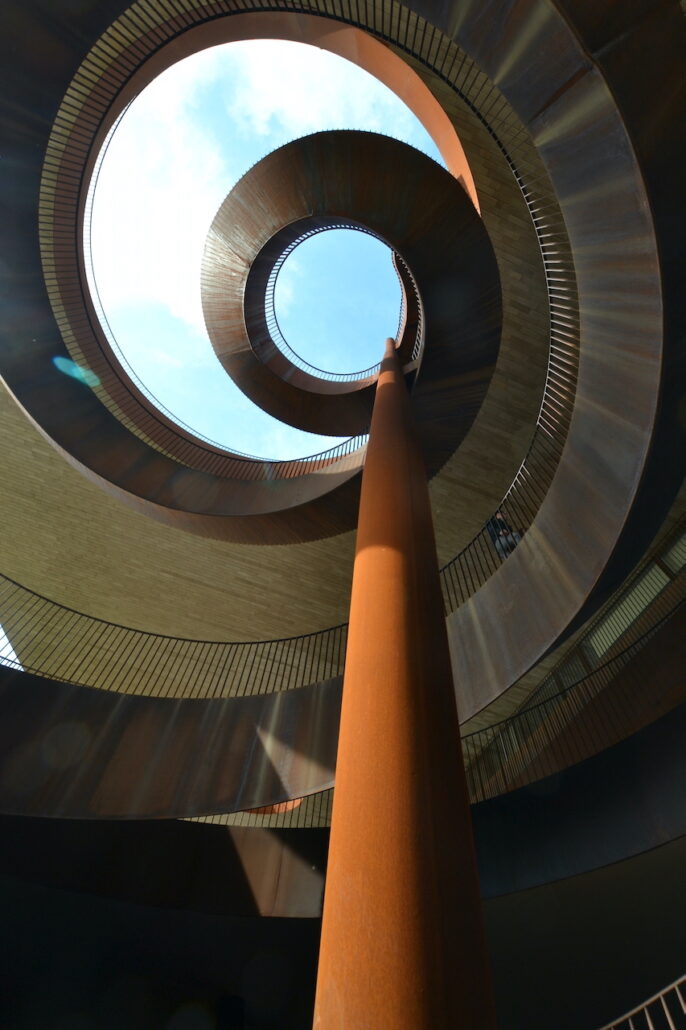
📍 Bargino
🏰 Antinori nel Chianti Classico: Six Centuries of Winemaking Excellence
Nestled in the rolling hills of Bargino, Tuscany, Antinori nel Chianti Classico stands as a testament to the Antinori family’s unwavering dedication to viticulture since 1385. This state-of-the-art winery seamlessly blends tradition with innovation, offering visitors an immersive experience into the world of Chianti Classico wines.
🌿 Estate Overview
Soil Type: Predominantly calcareous clay, ideal for Sangiovese cultivation
Location: Bargino, San Casciano in Val di Pesa, Tuscany, Italy
Altitude: Approximately 250 meters above sea level
Total Estate Size: 14 hectares, encompassing vineyards, olive groves, and oak woods
Vineyards: 4.6 hectares planted primarily with Sangiovese, along with Canaiolo, Ciliegiolo, Colorino, Malvasia Nera, Mammolo, and small amounts of Cabernet Sauvignon and Cabernet Franc
👨👩👧👦 The Antinori Family Legacy
The Antinori family’s winemaking journey began in 1385 when Giovanni di Piero Antinori joined the Florentine Winemakers’ Guild. Over 26 generations, the family has maintained a steadfast commitment to quality and innovation. In the 1970s, Marchese Piero Antinori revolutionized Italian winemaking with the introduction of Tignanello, one of the first Super Tuscan wines, breaking traditional DOC regulations by incorporating non-indigenous grape varieties and aging in barriques. Today, the family’s legacy continues under the leadership of Piero’s daughters: Albiera (CEO), Allegra, and Alessia, marking a new era of female leadership in this historic enterprise
🍇 Vineyards and Grape Varieties
- Primary Varietals: Sangiovese, Canaiolo, Ciliegiolo, Colorino, Malvasia Nera, Mammolo
- International Varietals: Cabernet Sauvignon, Cabernet Franc
- Viticultural Practices: Emphasis on sustainable farming and meticulous vineyard management to ensure the highest quality fruit
🍷 Signature Wines and Grape Composition
1. Villa Antinori Chianti Classico DOCG Riserva
- Grape Composition: Predominantly Sangiovese with complementary varieties
- Aging: Aged in oak barrels to enhance complexity and structure
- Tasting Notes: Elegant and well-balanced with notes of red berries, spices, and a hint of vanilla
2. Pèppoli Chianti Classico DOCG
- Grape Composition: Sangiovese blended with complementary varietals
- Aging: Aged in oak barrels to preserve fruitiness and freshness
- Tasting Notes: Vibrant and approachable with aromas of cherry, raspberry, and a touch of spice
3. Marchese Antinori Chianti Classico Riserva DOCG
- Grape Composition: Sangiovese with a small percentage of other red varietals
- Aging: Aged in oak barrels for added depth and complexity
- Tasting Notes: Rich and full-bodied with flavors of dark fruit, tobacco, and well-integrated tannins
4. Badia a Passignano Chianti Classico Gran Selezione DOCG
- Grapes: 100% Sangiovese
- Style: Deep, structured, refined
- Aging: 14–16 months in Hungarian and French oak barrels
5. Tignanello Toscana IGT
- Grapes: ~80% Sangiovese, 15% Cabernet Sauvignon, 5% Cabernet Franc
- Style: Iconic Super Tuscan—modern, complex, age-worthy
- Aging: French and Hungarian oak barriques
6. Solaia Toscana IGT
- Grapes: ~75% Cabernet Sauvignon, 20% Sangiovese, 5% Cabernet Franc
- Style: Bold, structured, world-class Super Tuscan
- Aging: Barriques for 18 months
7. Vinsanto del Chianti Classico DOC
- Grapes: Trebbiano Toscano and Malvasia Bianca
- Style: Sweet, traditional Tuscan dessert wine
- Aging: 3–5 years in small oak caratelli
🏡 Hospitality and Accommodations
While Antinori nel Chianti Classico does not offer on-site accommodations, visitors can find a range of nearby lodging options
🕰️ Wine Experiences and Tours
Antinori nel Chianti Classico offers a variety of immersive experiences for visitors:
- The Tinaia Tour: A guided exploration of the winery’s innovative architecture, production areas, and the family’s art collection, culminating in a tasting of three signature wines
- Bottaia Cru Tour with Lunch: An in-depth tour including a visit to the fermentation and aging cellars, followed by a curated wine tasting and a gourmet lunch at the on-site restaurant
Opening Hours:
- April – October: Monday to Sunday, 10:00 AM – 6:00 PM
- November – March: Monday to Friday, 10:00 AM – 5:00 PM; Saturday and Sunday, 10:00 AM – 6:00 PM
6. Badia a Coltibuono – Wine & Wellness
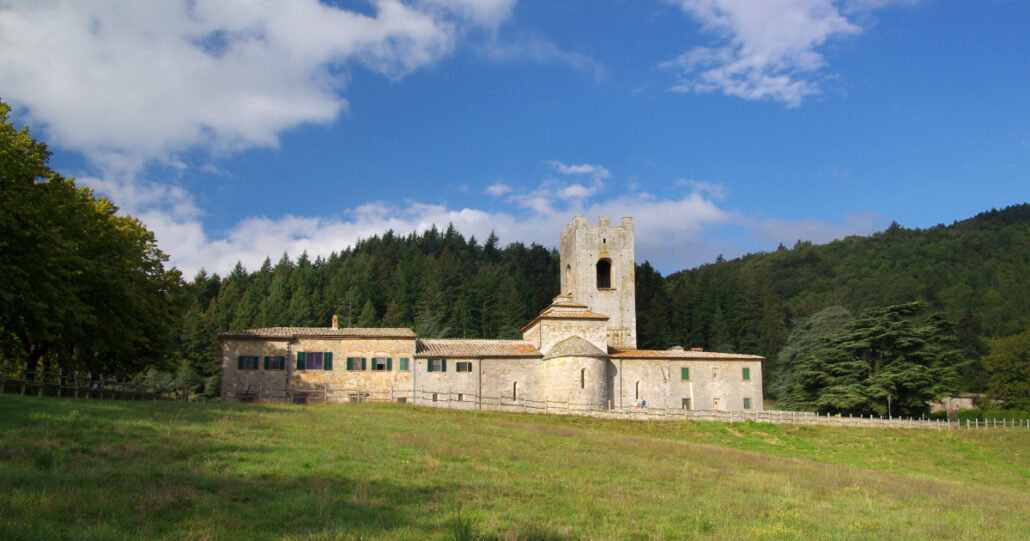
📍 Gaiole in Chianti
Situated in Gaiole in Chianti, Tuscany, Badia a Coltibuono—meaning “Abbey of the Good Harvest”—is a historic estate founded in 1051 by Vallombrosan monks. Over the centuries, it has evolved into a renowned winery and hospitality destination, seamlessly blending ancient traditions with modern sustainability practices.
🌿 Estate Overview
- Location: Gaiole in Chianti, Siena, Tuscany, Italy
- Total Estate Size: Approximately 700 hectares (1,730 acres), with 70 hectares (173 acres) under vine
- Vineyards: Located in Monti and Vitignano, featuring native clones of Sangiovese and other traditional varieties
- Farming Practices: Certified organic since 2000, adhering to sustainable and biodynamic principles
- Altitude: Vineyards situated at elevations around 600 meters, benefiting from optimal sun exposure and temperature variations
👨👩👧👦 The Stucchi Prinetti Family Legacy
In 1846, the Florentine banking family Giuntini, ancestors of the current owners, acquired the estate. Today, the Stucchi Prinetti family—specifically siblings Emanuela, Roberto, and Paolo—continues to uphold the estate’s rich heritage. Roberto Stucchi Prinetti, an esteemed oenologist, oversees the winemaking process, ensuring that each bottle reflects the authenticity and quality synonymous with Badia a Coltibuono.
🍇 Vineyards and Grape Varieties
- Primary Varietals: Sangiovese (comprising approximately 90% of plantings)
- Complementary Varietals: Canaiolo, Ciliegiolo, Colorino, Foglia Tonda, Malvasia Nera, Mammolo, Pugnitello, Sanforte, and Trebbiano
- Viticultural Practices: Emphasis on organic cultivation, biodiversity, and the preservation of indigenous grape varieties
🍷 Signature Wines and Grape Composition
1. Chianti Classico DOCG
- Grape Composition: 90% Sangiovese, 10% traditional Tuscan varietals (e.g., Canaiolo, Ciliegiolo, Colorino)
- Aging: 12 months in large oak casks
- Tasting Notes: Bright red fruit, floral aromas, balanced acidity, and soft tannins
2. Chianti Classico Riserva DOCG
- Grape Composition: 90% Sangiovese, 10% Colorino, Canaiolo, Ciliegiolo
- Aging: 24 months in large oak barrels
- Tasting Notes: Complex layers of cherry, spice, and earthy undertones with a long finish
3. Cultusboni Chianti Classico Riserva DOCG
- Grape Composition: Predominantly Sangiovese with select traditional varietals
- Aging: Extended maturation in oak to enhance depth and structure
- Tasting Notes: Rich and elegant, showcasing dark fruit, tobacco, and subtle oak nuances
4. Sangioveto Toscana IGT
- Grape Composition: 100% Sangiovese
- Aging: Aged in barriques after extended maceration
- Tasting Notes: Intense and full-bodied with notes of ripe cherry, leather, and spice
5. Montebello Toscana IGT
- Grape Composition: Blend of nine indigenous grape varieties, including Sangiovese, Canaiolo, Ciliegiolo, Colorino, Malvasia Nera, Pugnitello, Mammolo, and Sanforte
- Aging: Aged in oak barrels to develop complexity
- Tasting Notes: A unique expression with layers of red fruit, herbs, and earthy tones
6. Vin Santo del Chianti Classico DOC
- Grape Composition: Trebbiano and Malvasia
- Aging: Traditional aging in small oak casks (caratelli) for several years
- Tasting Notes: Amber-hued dessert wine with flavors of dried fruit, honey, and nuts
🏡 Hospitality and Accommodations
Badia a Coltibuono offers a serene retreat with accommodations that reflect the estate’s historical charm:
- Apartments: Four elegantly furnished apartments—Granaio, Magnolia, Chiostro, and Fattore—each featuring unique décor and modern amenities
- Guest Rooms: Eight double rooms with en-suite bathrooms, offering views of the Renaissance gardens, Valdarno valley, or the courtyard
- Amenities: Guests have access to common areas, the Italian-style garden, and a seasonal outdoor swimming pool
🍽️ Culinary Experiences
The on-site restaurant at Badia a Coltibuono serves dishes inspired by traditional Tuscan cuisine, emphasizing local and organic ingredients. The menu reflects a balance between historical recipes and contemporary culinary techniques.
- Opening Hours: Open daily (closed on Mondays); Lunch: 12:00 PM – 2:30 PM, Dinner: 7:00 PM – 9:30 PM
- Reservations: Recommended via email
🕰️ Wine Experiences and Tours
Visitors can immerse themselves in the rich history and winemaking traditions of Badia a Coltibuono through various experiences:
- Abbey Tours: Guided tours of the historic abbey and its Renaissance gardens
- Wine Tastings: Sampling of the estate’s organic wines, including Chianti Classico and Vin Santo
- Cooking Classes: Hands-on classes focusing on traditional Tuscan recipes
Booking: Reservations can be made through the estate’s website or by contacting the hospitality team directly

Is Chianti Considered “Cheap Wine”?
Absolutely not. While Chianti wines are accessible and widely available, the best producers craft high-quality, age-worthy wines that rival top wines from around the world. From entry-level Chianti to Chianti Classico Gran Selezione, there’s a spectrum of excellence.
FAQs About Visiting Chianti Wineries
Do you need to book wineries in Chianti?
Yes. Most top wineries require advance bookings, especially for English-speaking tours or small group tastings.
What are the best wineries in Chianti?
Some top picks include Castello di Verrazzano, Volpaia, Antinori, and Castello di Radda. Each offers a distinct experience—from medieval cellars to cutting-edge architecture.
What is the best vineyard to visit in Tuscany?
It depends on your style. For scenic history: Castello di Verrazzano. For innovation: Antinori nel Chianti Classico. For tranquility and organic wines: Badia a Coltibuono.
Chianti wineries to visit: Where should you go?
Popular favorites include Castello di Radda, Volpaia, Nozzole. A guided tour helps you discover hidden gems.
What is the best wine tour from Florence?
The best tours include visits to 2–3 wineries, food pairings, and scenic drives through the Tuscan countryside. Choose small group wine tours for a more personal experience.
Is there a Chianti wineries map I can follow?
Yes—many visitors use the Strada del Vino Chianti Classico route, which links dozens of top wineries. Or join our Florence to Chianti wine tour for a curated itinerary with zero planning stress.
Is Chianti considered cheap wine?
Not at all. While Chianti is more affordable than many premium regions, the quality—especially in Chianti Classico and Gran Selezione—is outstanding.
Are Tuscany and Chianti the same?
Chianti is a subregion within Tuscany. Tuscany includes several wine areas, but Chianti is the most famous for red wines made primarily from Sangiovese grapes.
Why Choose Our Chianti Wine Tour?
- 🚐 Round-trip transport from Florence
- 🍷 Tastings at 3 top-rated wineries
- 🍝 Food pairings with local Tuscan dishes
- 🧑🏫 Expert English-speaking guide
- 👥 Small group size (max 8 guests)
- 🌿 Exclusive access to family-run estates
Whether you’re sipping Chianti under the sun, walking through 12th-century cellars, or discovering how terracotta amphorae are used to age wine—you’re not just visiting, you’re immersing.
Your 2025 Chianti Wine Tour Awaits
Chianti offers more than wine—it’s a story told through landscapes, flavors, and passionate winemakers. Ready to write your chapter?
Book your Chianti wine tour today and toast to the best of Tuscany.


